Climbing Mount Vesuvius to see the still-smoking crater at the top is a great add-on to a trip to Pompeii. The eruption of Vesuvius in AD 79 is what destroyed Pompeii, so making a trip up the volcano is a really awe-inspiring experience which will help deepen your understanding of the area.
I spent an afternoon on my trip to Naples and Sorrento visiting Mount Vesuvius. Getting to Vesuvius and the Great Cono crater is a little more complex than you might expect, so I’ve put together some tips for your visit.
About Mount Vesuvius
Mount Vesuvius is one of the most well-known volcanoes in the world, not just for its towering presence over the Bay of Naples, Italy, but for its explosive history that has captivated historians, geologists, and tourists alike.
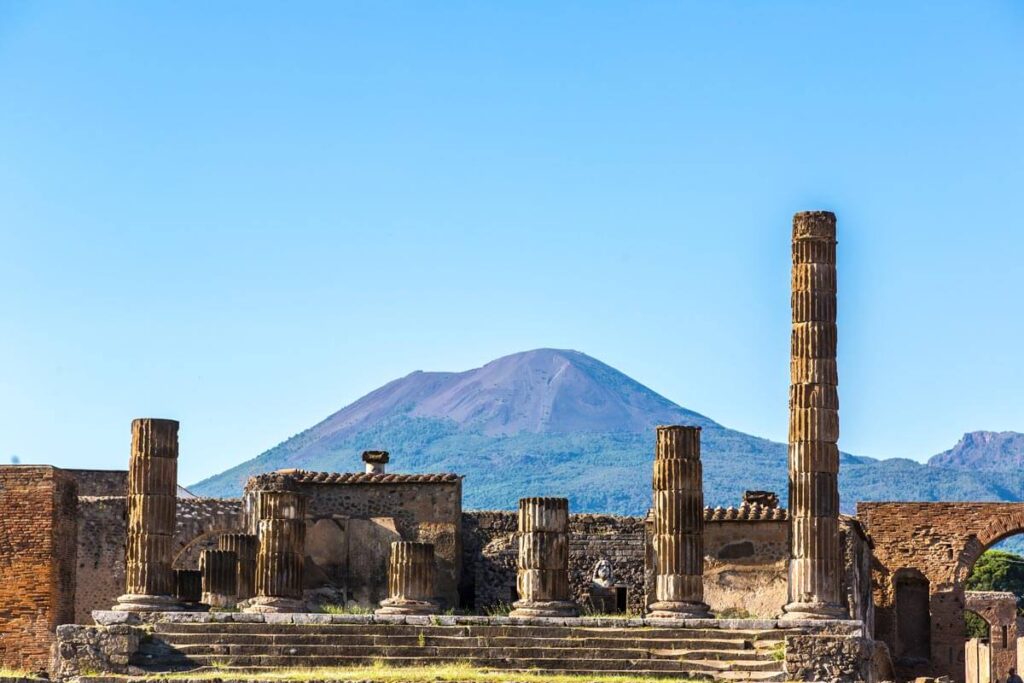
Vesuvius is currently 1,281 metres high, but it used to be much taller. Four huge eruptions between 18000 BC and AD 79 took the top off and formed the caldera and second peak that you see today. Its current dramatic jagged peak is what was left behind after the most recent eruption in 1944.
The volcano is currently regarded by volcanologists as one of the most dangerous in the world. It’s only 12 miles from the centre of Naples and 800,000 live in the so-called “Red Zone”. If there was another eruption like the one which buried Pompeii, the pyroclastic flow would reach Naples in 2.5 seconds. Luckily, Vesuvius is continually monitored by volcanologists at the National Institute of Geophysics and Volcanology‘s Vesuvius Observatory.
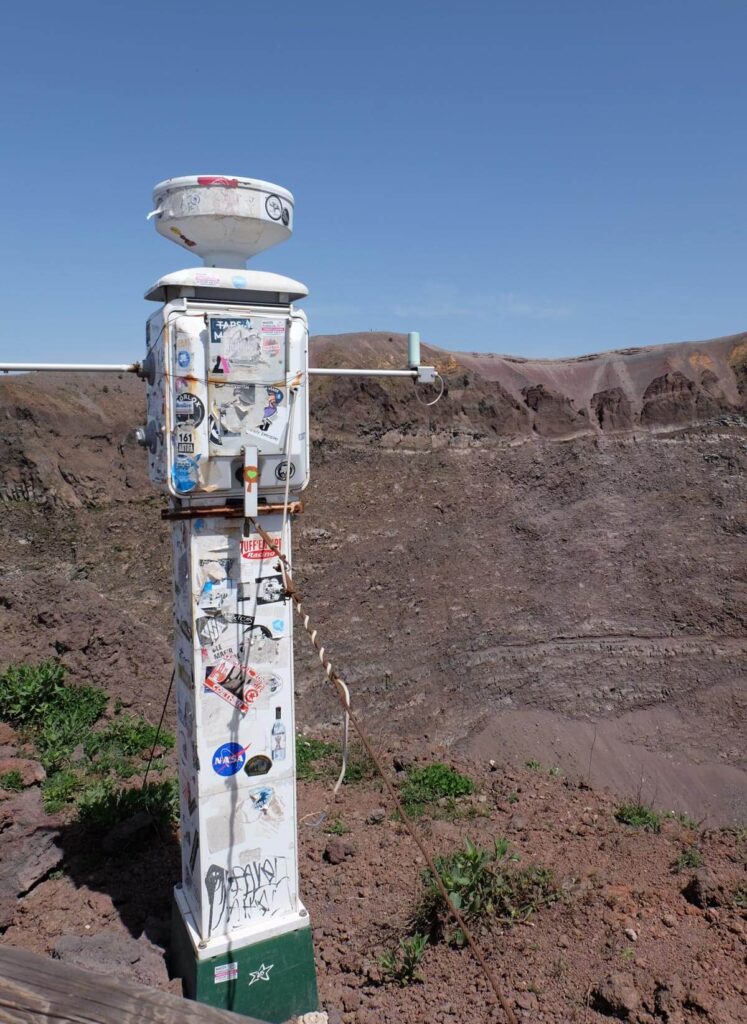
The Great Cone and the slopes of Mount Vesuvius has been a National Park since 1995 to help preserve the animal and plant life on the mountain, as well as the geological features.
Now for the tips for visiting Mount Vesuvius.
You have to walk up to the crater
Access to Vesuvius’s crater is by foot. While some bus tours can drop you off at the car park at 1000 metres up the mountain, there’s no public vehicle access to the top. Unfortunately this means that if you can’t do the climb, you won’t be able to see the crater.
You need tickets for Mount Vesuvius
Entrance to the upper part of Vesuvius is by timed ticket, to help protect the volcano from damage from too many feet. There’s an e-gate at the start of the walk up to the Great Cone, and all tickets have to be booked online.
If you’re planning a DIY visit to Vesuvius rather than taking a tour, I recommend booking your entry ticket as soon as you know when you’d like to visit as tickets can sell out a week in advance in peak season. To book tickets, go to the official site to register and choose your entry slot.
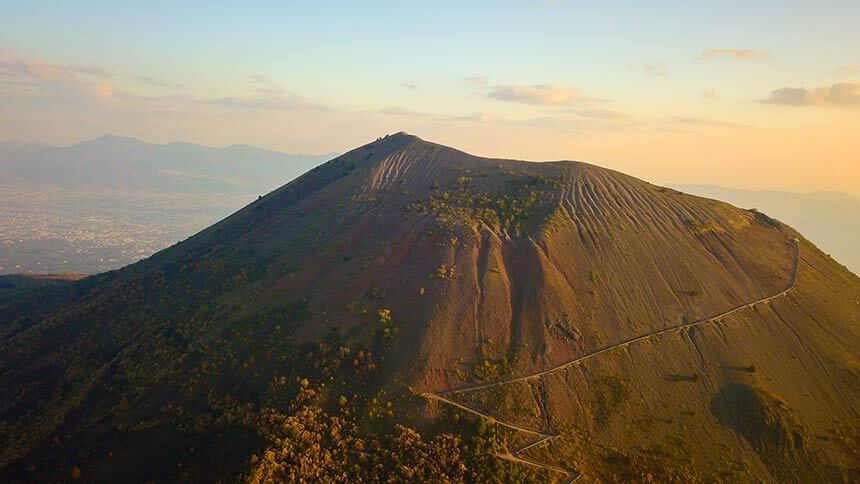
If you’re unlucky and don’t manage to get tickets, you may be able to get last minute tickets on the official site. In theory, 10 extra tickets are released an hour in advance of the next slot, but recent reports say that this can be hit and miss. Be aware that internet access on the slopes of Mount Vesuvius is extremely patchy so you may not want to rely on being able to buy tickets at the gate!
If all this is sounding quite stressful, I’d recommend taking an organised tour (which includes tickets) to be sure of getting up the mountain. This might be a guided tour which includes Vesuvius as well as other attractions, or there are bus transfers which include tickets too.
Top-rated Mount Vesuvius tours
Vesuvius Express transfer from Ercolano station with Great Cone tickets
Getting to Mount Vesuvius
There are a few options for getting to Vesuvius.
Tip: Because of the complicated ticketing system for getting to the top of Vesuvius, I recommend using either the Vesuvio Express tourist bus transfer from Ercolano with tickets included or taking a guided tour.
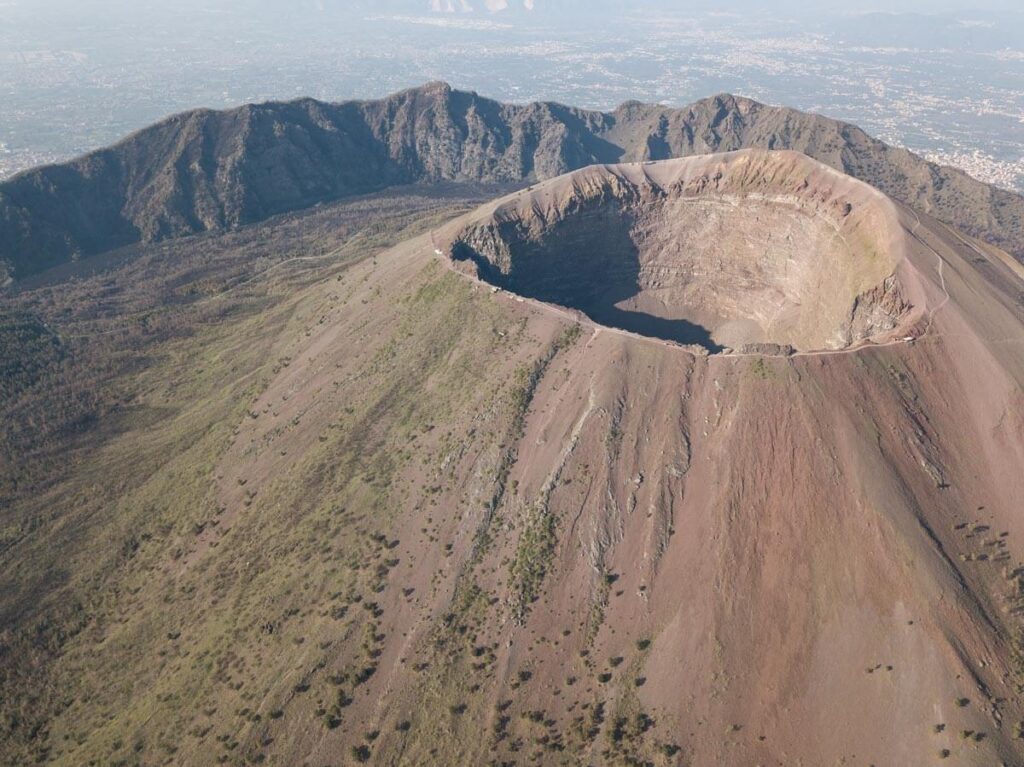
Tourist bus transfer from Ercolano with Vesuvio Express
When I climbed Mount Vesuvius we didn’t have a car, so I chose to take a bus transfer from Ercolano (where I’d just visited the Herculaneum archaeological site). My trip was with Vesuvio Express, which was a really easy way to get there and included tickets for the crater, so I didn’t need to coordinate ticket bookings and transfer times.
On leaving the station in the direction of the Herculaneum ruins you’ll come out in a little square. Head to the left and you’ll see the Vesuvio Express office for the bus trip up the mountain. Try to get to the office as quickly as you can – if you’re at the back of the queue and the bus fills up you might need to wait for the next one.
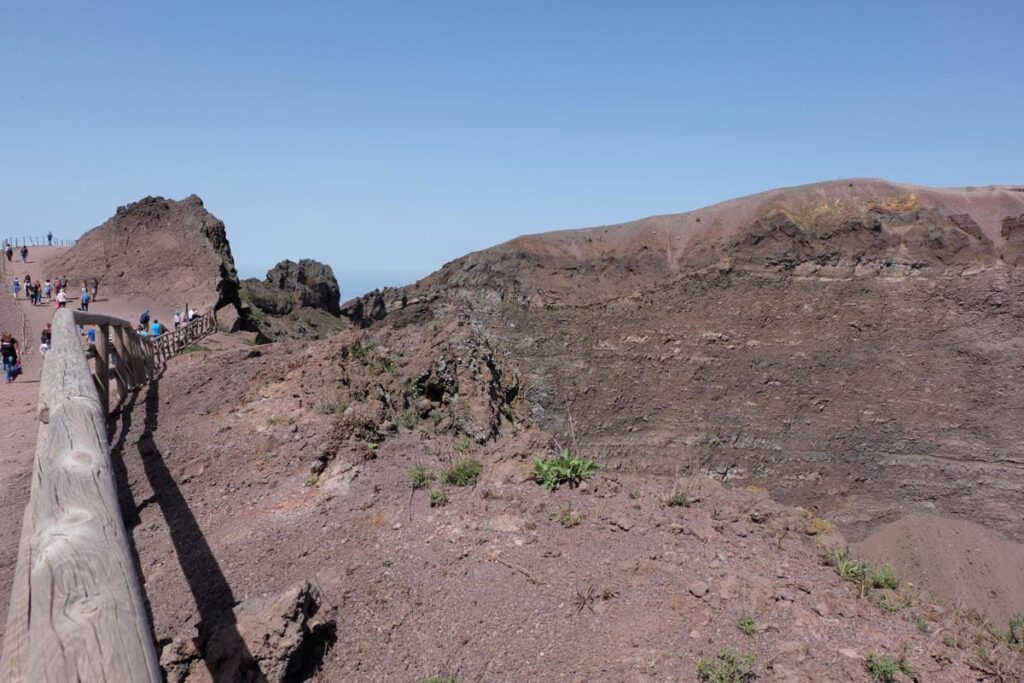
The return trip from Ercolano to Mount Vesuvius with Vesuvio Express costs 32 euro each including entrance to the crater. It’s not a guided tour, it’s literally just to get you to the start of the hike to the summit but we found it reasonably priced and efficient.
Vesuvio Express block-book tickets for the crater so you don’t need to book your tickets for the crater (or Great Cono) separately – although there’s a couple of euros markup on the Vesuvius ticket price.
You can book tickets for Vesuvio Express online. There are options for just the transfer, but I recommend the combined Roundtrip + Vesuvius ticket option. For me the combined ticket was worth it as crater tickets sell out at least a day in advance and getting a bus up at the right time to make our ticket slot felt really risky.
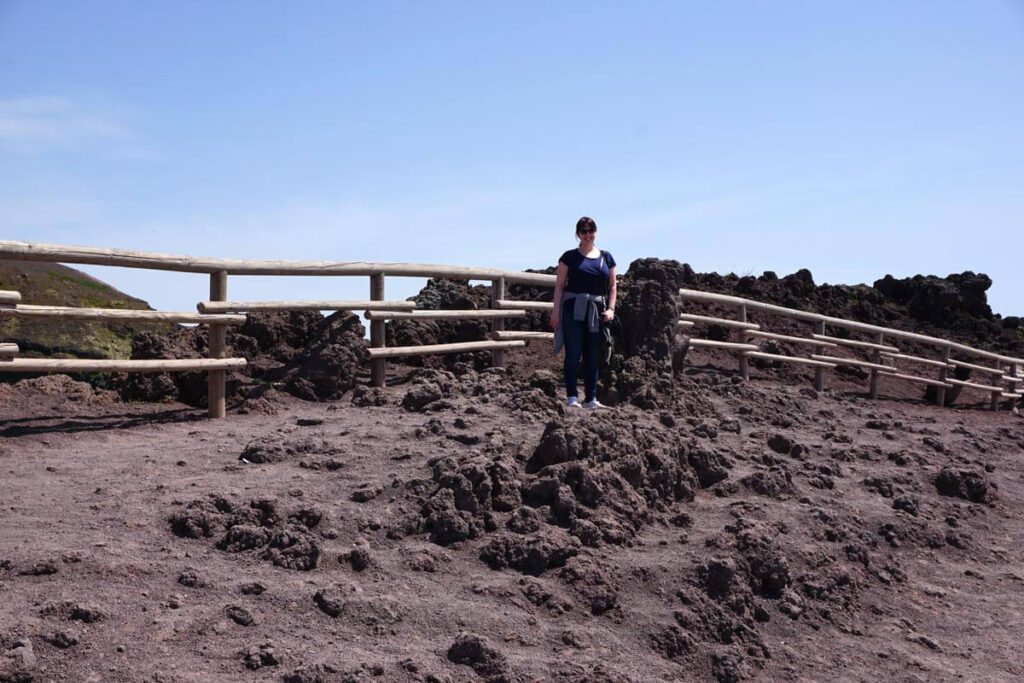
The bus takes around half an hour to wind its way up the lower part of the mountain. You’ll be let out at the upper car park at 1000 metres up the mountain (this isn’t actually a car park – read on for how to drive to Vesuvius) and will have around an hour and a half to get up the mountain, look around and get down again to catch your return bus. If you miss it you’ll have to pay again or make your own way back.
Vesuvius guided tours
There are a few tour providers who provide trips to Vesuvius from Naples and from Sorrento, often combined with wine-tasting and lunch at a vineyard on the slopes of the mountain. Wines from Vesuvius received the coveted DOC status in 1983 and can be produced in red, white, rosé and sparkling varieties.
There are also lots of tours which combine a trip to Pompeii with the hike up Vesuvius. I needed more time at Pompeii than these would have given me, but they’re a good option if you’re short on time.
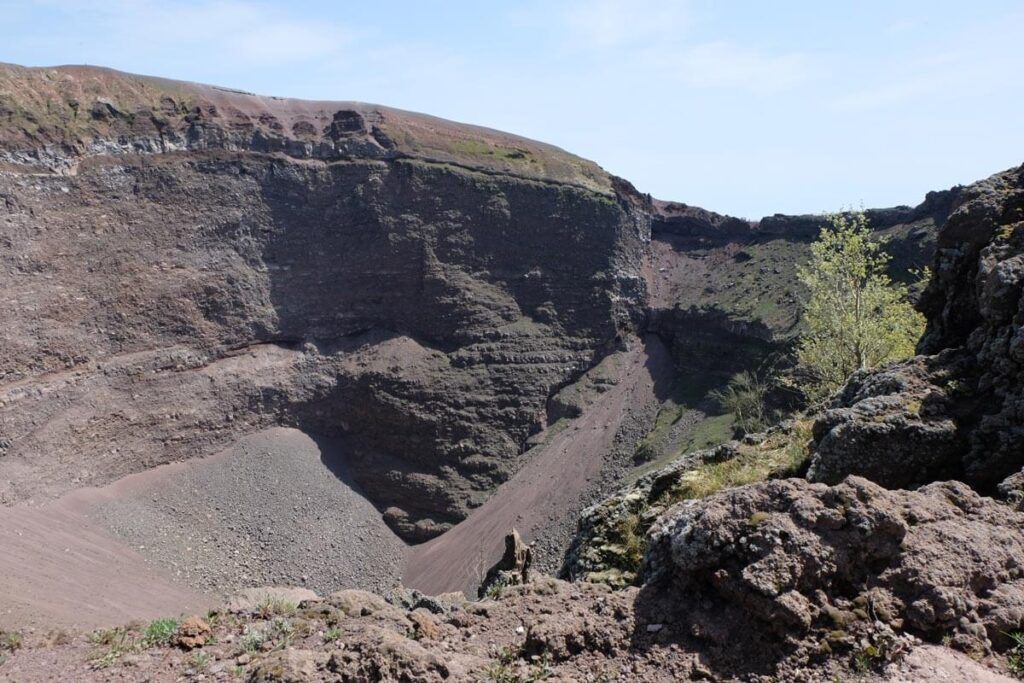
Public bus from Pompeii
You can take a public bus from Piazza Anfiteatro in Pompei to Mount Vesuvius. If you do take the public bus, you’ll need to also book tickets to visit the crater.
By car
There are two official car parks for visiting Vesuvius, both run by the local Ercolano council. The closest one, parking area B, is at 800 metres up the mountain, while the entrance to the trail to the crater is at the upper car park at 1000 metres. The upper car park is reserved for shuttle buses – you can’t actually park there.
Spaces are limited at the parking places so it’s best to book your space online, especially if you’re travelling in a large car or camper van. The mobile connection is patchy on the mountain so book both the parking and your entrance to the crater before you leave and make sure you’ve downloaded your booking confirmations before you get there.
Booking parking gets you a space for 4 hours. To get from parking area B to the entrance to the trail up to the crater you can either walk along the road, which takes around 40 minutes, or for 3 euro per person each way you can take a shuttle bus, which takes about 4 minutes.
What it’s like to climb Vesuvius
When I was reading reviews of what it was like to climb Vesuvius, a lot of them made it sound like an easy stroll, but it’s important to know before you set off what it’s going to be like.
From the upper car park where tour buses and the Vesuvio Express bus drop you off, it’s about a mile to Vesuvius’s crater. The walk is all uphill; it’s not a particularly steep slope, but it’s pretty constant. Take your time, bring some water and it’s achievable for most reasonably fit people.
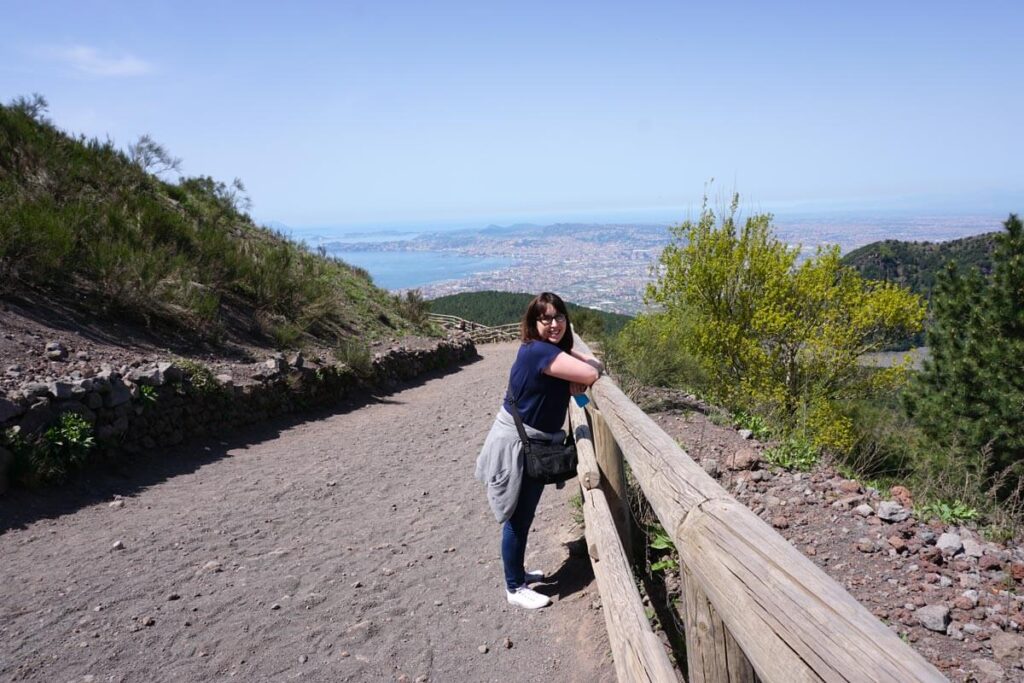
There are people offering walking sticks at the start of the climb and I would have found one really helpful. They’ll expect a cash tip of around €10 on your return.
I was a little worried that because we had to be back for our bus at a certain time, that I wouldn’t be able to get up to the crater and back again within 90 minutes, but we did end up having around 20 minutes at the top, which was plenty.
The thing that makes it perhaps more difficult than it should be is the surface of the path. It’s fine, dusty gravel underfoot which slides a little as you step on it. I recommend wearing shoes rather than sandals, and something with a bit of grip to help with the sliding.
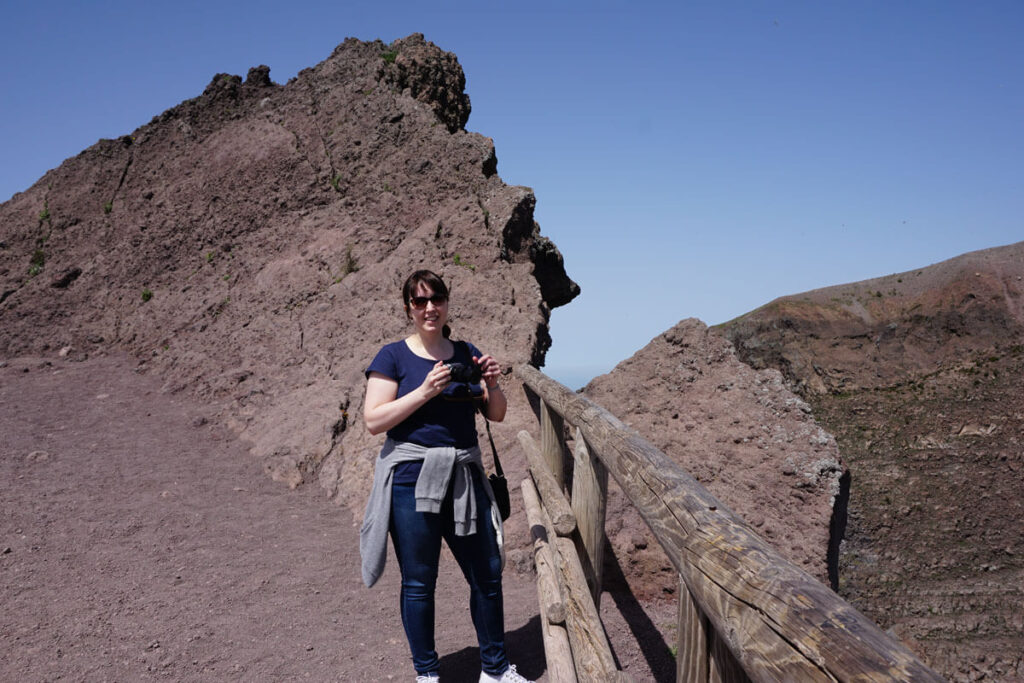
Ideally they shouldn’t be shoes that you’re particularly precious about, as the red Vesuvius dust gets everywhere – my new white trainers were pretty much ruined by the end of our hike!
What you can see at the top
The main attraction for me at the top of Vesuvius was the great crater. It’s absolutely huge and although there are bushes growing on its slopes, the occasional puff of sulphur-y smelling smoke reminds you that this is still an active volcano. Looking down into the crater, it’s truly astonishing to think of the forces down there and the enormous destruction it has wrought in the past – and what it might do in the future.

You can’t walk into the crater, but you can walk part of the way around the edge to see it from different angles.
There are great, far-reaching views, but you’re so high up here that you can’t really see the detail of places like Pompeii or Naples. You can see the shape of the coast and the island of Capri, but even on a relatively clear day it was quite hazy.
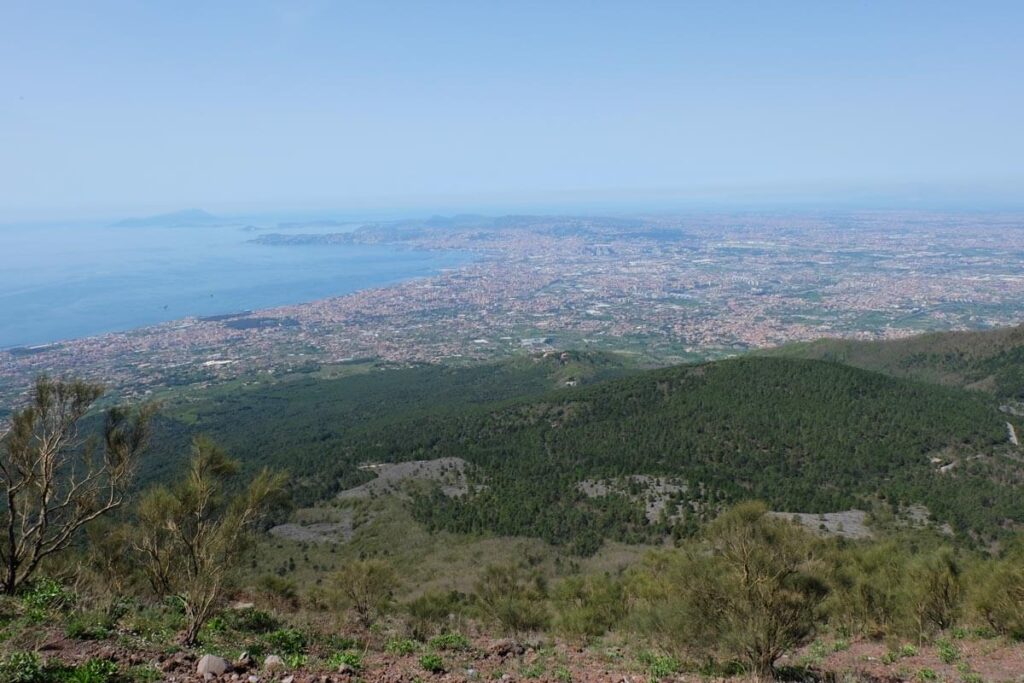
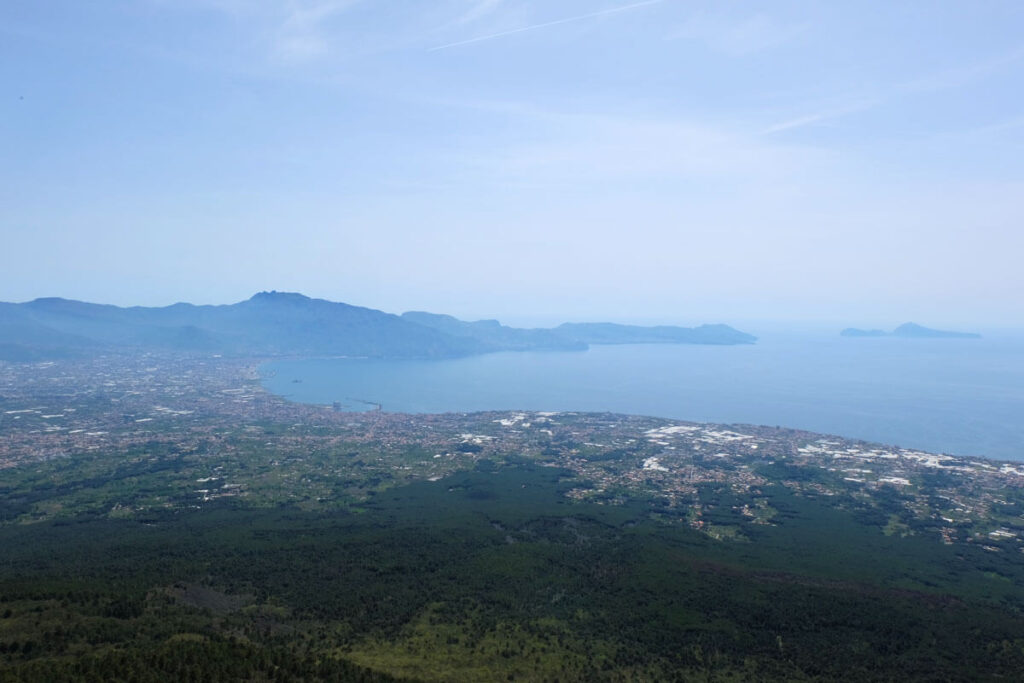
The other reason that the view from Vesuvius isn’t as impressive as other views in the area is that it’s missing something – the great mountain right in the middle of it all. After all, you can’t see it when you’re up it!
Facilities at Mount Vesuvius
Vesuvius is one of the most popular attractions in the Naples area, so you might be expecting a visitor centre or perhaps a cafe on site. Unfortunately facilities at Vesuvius are extremely rustic – just a couple of souvenir shops at the top car park and a kiosk selling drinks, snacks and souvenirs at the top, near the crater.
There also aren’t any toilets on Vesuvius, which I discovered way too late. I got myself nice and hydrated for the climb and arrived back at the bus stop absolutely bursting. I begged at the shop to use their (non-flushing) toilet in exchange for buying something but it wasn’t a very pleasant experience! I strongly advise that you go to the toilet before you arrive on the mountain.
In summary
I may have moaned a bit on the walk up, but I did really enjoy our trip to Mount Vesuvius. Seeing the crater of this iconic volcano was absolutely awe-inspiring and gave me a profound respect for the power of nature.
We’d already visited Pompeii (see my tips for visiting Pompeii) and we’d been to Herculaneum that morning, so going to the top of Mount Vesuvius was the perfect way to round off our trip to this part of Italy.
If you have any questions about visiting Vesuvius, let me know in the comments!
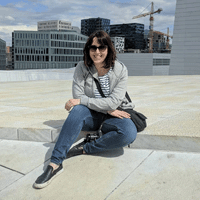
About Helen
Hi! I’m Helen, and Italy is one of my favourite destinations. I’ve been fascinated by ancient Roman and Greek history since I was a kid and I love nothing more than combining a visit to a Roman site with experiencing Italy’s beautiful landscapes and cities.
I live near Manchester, UK and work full time, so I’m all about making the most of my annual leave with day trips, weekend getaways and short breaks.

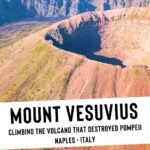
Hi Helen,
Your blogs are so easy to read and make doing my research really easy. One question, should I buy the Express ticket to Vesuvius on the way to Herculaneum, or after we’ve visited?
Thanks, Deborah
Thank you Deborah 🙂 I’d be inclined to either book in advance or call in at the Vesuvio Express office by the station on your way to Herculaneum. A morning visit to Herculaneum, some lunch then the trip up Vesuvius would be perfect.